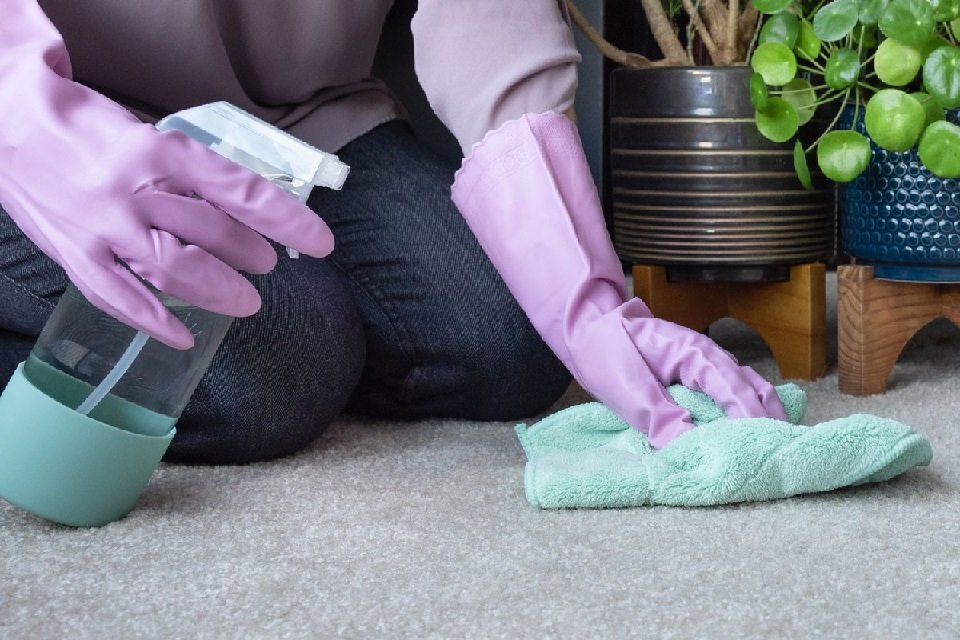Mould is a pesky fungus that loves damp spots like bathrooms and basements. It spreads when tiny spores land on wet surfaces.
Cleaning it up is one thing, but stopping it from coming back is super important because mould can mess with your health, causing allergies, asthma flare-ups, and breathing problems. Plus, it can seriously wreck your home, damaging walls and ceilings.
Keeping mould away helps protect your place and keeps you healthy. So, taking steps to stop it is a smart move for a safe and comfy home.
Mould Prevention through Thorough Cleaning
Before you focus on keeping mould from coming back, it’s crucial to tackle the mould that’s already there.
Start by mixing a simple solution of water and detergent—say, a cup of detergent in a bucket of water. This combo is great for wiping away mould on many surfaces.
Make sure you really coat those stubborn spots, then give them a good scrub. Once you’ve finished, rinse the area thoroughly to wash away any leftovers.
When it comes to things like carpets and ceiling tiles, if they’re heavily infested, it’s often best to just get rid of them. These materials soak up mould like a sponge, making them tough to clean and more likely to cause future problems.
It might feel like a bit of a loss to toss them out, but it’s a vital step in keeping your home healthy and mould-free for the long haul. If the job feels overwhelming, don’t hesitate to call in the pros for a bit of extra help.
Drying Surfaces Quickly
To keep mould from making a comeback, drying surfaces right after cleaning is vital. Mould thrives in moist spots, so keeping things dry is crucial. Fans are great for circulating air, especially in those damp corners.
Open windows when you can; let fresh air in and push out the dampness. If the humidity’s a bit much, a dehumidifier can help remove excess moisture. Aim to get everything dry within 24 hours of cleaning to keep mould at bay.
Imagine your basement is always a bit wet. Pop a fan in there to speed things up. After a shower, crack open the bathroom window to stop mould from returning. Keeping everything dry after cleaning really reduces the chance of mould reappearing.
So, why not give it a try? A little effort now saves a lot of hassle later!
Regular Maintenance Checks
Doing monthly checks around the house is a clever way to keep mould from sneaking back in. Focus on areas like the bathroom, basement, kitchen, and laundry room—places that often get a bit damp.
Keep an eye out for watermarks, odd smells, or condensation, as these can hint that mould might be hiding.
Having a checklist can make sure you don’t miss anything important. You might want to include things like checking for leaks under the sink and making sure the seals around your tub and shower are still in good shape.
It’s also wise to see if your vents are doing their job and keeping the air moving nicely. Making these checks a regular habit means you can catch little issues before they become big headaches, which will save you money and keep everyone healthier.
Plus, keeping mould at bay makes your home a much more pleasant place to be. Why not start this routine today and share your tips with friends and family?
To ensure that your home remains mold-free, it’s crucial to maintain proper ventilation and humidity levels. Regularly inspect and clean your HVAC system, as it plays a significant role in air circulation. If you’re near Cleburne and need professional assistance, consider reaching out to Andersen Air Inc near Cleburne for expert advice and services. They can help optimize your system to prevent mold growth effectively. Additionally, using dehumidifiers in damp areas and ensuring that your home is well-insulated can further reduce the risk of mold returning. Remember, consistent maintenance is key to a healthy, mold-free environment.
Using Mould-Resistant Products
When sprucing up your home, it’s worth considering materials that fend off mould. Imagine the peace of mind knowing your bathroom and kitchen are safeguarded by mould-resistant paint, which helps stop those pesky spores from settling in.
And if you’re dealing with damp areas, mould-resistant drywall is a smart choice, offering better protection than the ordinary kind. Don’t forget about moisture-resistant insulation, which can be a game-changer for keeping your walls dry and cosy.
Sure, these materials might cost a tad more initially, but think of the long-term savings by bypassing costly repairs and avoiding unwanted mould invasions.
Choosing materials that actively fight mould is a clever step towards a more comfortable and durable home. Why not check out your current options and see where you can make improvements? Your future self will thank you!
Controlling Indoor Humidity Levels
Keeping your home’s humidity in check is a big deal if you want to steer clear of mold. You see, mould just loves damp environments, so keeping the moisture levels down can really help keep it at bay. Aim to maintain your indoor humidity below 50%.
Wondering how to measure that? A hygrometer can be your new best friend. It’s a handy little gadget that tells you the current humidity level, letting you make adjustments when needed. Think of it as your personal weather reporter for your living room.
Now, if you’re dealing with spots like basements that tend to be a bit damp, a dehumidifier can work wonders. It helps by pulling excess moisture out of the air. Just remember to check the water container often and empty it out.
No one wants a dehumidifier that’s all full and can’t do its job! Air conditioners also lend a hand by circulating and cooling the air, which naturally reduces humidity.
Don’t forget about exhaust fans, especially in kitchens and bathrooms. These little heroes help whisk away moist air, preventing it from settling in and causing trouble. Placing a hygrometer on a shelf in these rooms can give you a quick peek at how things are going.
By regularly keeping tabs on your home’s humidity and making small tweaks, you make it tough for mould to take hold. This means a healthier, more comfortable living space for you and your family.
Importance of Proper Ventilation
Ensuring your home is well-ventilated is super important, especially in moisture-heavy spots like bathrooms and kitchens. Installing exhaust fans is a brilliant move since they really help to whisk away damp air, lowering the chances of mould making an unwelcome appearance.
It’s smart to flick these fans on while you’re showering or cooking and leave them running for about 15 to 20 minutes afterwards to clear any lingering moisture.
Simply opening windows can also do wonders for air circulation, particularly if your ventilation needs a helping hand. This not only invites fresh air in but also lets excess moisture escape, keeping your home’s air nice and balanced.
Imagine cracking a window during a hot shower or when you’re boiling the kettle; it can significantly reduce humidity levels.
By embracing these ventilation tips, you’ll not only boost your home’s air quality but also fend off mould, leading to a healthier living space.
So, why not make these simple habits part of your daily routine? You’ll find they make a noticeable difference to both your home and your well-being.
Conclusion
Stop mould in its tracks to keep your home healthy and stress-free. Try cleaning thoroughly, drying things quickly, checking regularly, and using mould-resistant materials. Keep the air dry and let it circulate to make it hard for mould to settle.
These simple steps will protect your home from mould. Act now to safeguard your living space—it’s worth it for a fresher, cleaner home!




